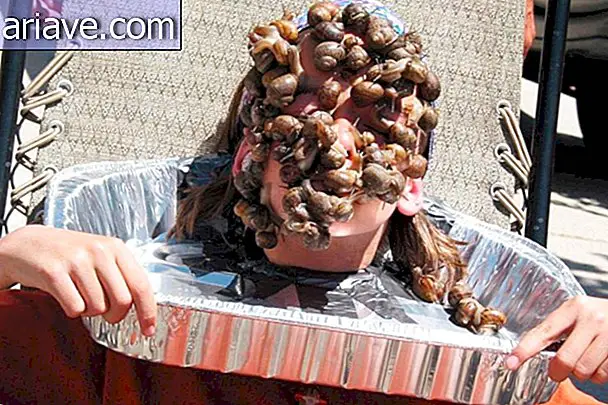Meet the parasitic worm that turns crickets into suicidal zombies
If you enjoyed our zombie parasite publication, you will probably love to meet the “quirky” animal we will be presenting here, but if you are the type who has no nerves of steel and feel sick just thinking about things like that, you might want to read something lighter. Get ready, because the filth of the day is related to a very special type of worm.
Better known as “hair” or “horsehair worms, ” nematomorphs are parasites that invade the body of insects. After developing for several months, these animals mentally control their hosts through a suicidal voyage into the water, then escape through holes that they themselves drilled in their exoskeleton. The insect is left behind - often still alive.
These animals can be found in swimming pools, streams, puddles, and cisterns, and their common name is attributed to the fact that in the past people actually thought they were from horses that came out of their inanimate state upon contact with water.
A new house
Speaking more precisely about the species Paragordius varius, these animals are found in various streams and rivers throughout the Americas. They hatch from their larva-shaped eggs and wait in the background. Unable to swim to the surface, the tiny larva simply waits to be swallowed by the larvae of other insects such as mosquitoes and moths.
When metamorphoses of insects occur, they come out of the water to live their air lives with the larva in tow, until they are eaten by crickets. Once the worm's larva is inside the insect, it will penetrate through the cricket's gut and enter the body cavity, where it grows from a larva barely visible to the eye to a 30 cm long worm - not the case. Paragordius varius, but there are species that reach up to 1 meter in length.

In fact, these nematomorphos are nothing more than giant gonads wrapped in a thin covering of muscles. Interestingly, they do not even have a mouth to eat or make their hole inside the cricket. Scientists like Ben Hanelt, a parasitology expert at the University of Mexico, say they are unsure how these parasites pierce their way out of the insect in order to escape.
They also have no digestive system, at least not the kind we are used to seeing. “The way these guys get their nutrients, in fact, is directly through the cuticle, ” says Hanelt. “It is through the skin of this worm that fat and sugar are absorbed directly from the host's body fluids.” Juicy, isn't it?
Gril Zombies
It is almost impossible to identify an infected cricket, so we are not talking about the clumsy zombie stereotype we know. Observed from the outside, the cricket behaves quite normally, except for the brilliant little trick the worm uses: it manipulates its host and shuts it up.
Chirping - the name given to the act of making "cri-cri" - is energy-intensive, not to mention a remarkable way to make yourself and increase the risk of being eaten by predators. And a parasite that's smart enough to control the brain of another living being doesn't want to be devoured by nonsense.
However, it is easy to find out when the worm leaves one of these insects. Typically, crickets are very far from running water, hydrating and taking their food only in the dew. According to Hanelt, throwing an uninfected cricket into the stream will surely cause it to flee away, but an infected cricket is an excellent swimmer.
Ordered by the worm, it seeks large amounts of water with its antennas, which capture even the slightest change in humidity. "A cricket that has a worm inside it, " says Hanelt, "and that is near the water, will always jump right into it."
After admiring the “cannon ball” style dive, the worm, which monitors the outside environment through the cricket's hole, has its big moment: it twists and drops its host as soon as they are both in the water.
Freedom at last
Usually there is only one parasite per insect, although every now and then two or three may come out. Hanelt says, however, that in his lab the record was 32 worms emerging from a poor host. In the video below, there must be nearly a dozen digging their way into the open world.
The now free parasite will swim until it finds a mate. The male dies after fertilizing the female. This in turn lays the unbelievable amount of 15 million eggs, which are glued to a submerged stone or stick. After performing her role, she also dies. Two weeks later, their eggs hatch and the larvae remain at the bottom of the river, beginning the process once again.
But what is the secret of mind control?
It's amazing to think about an organism that has adapted over time to manipulate another and use it as its personal escort, but how can a worm hack a cricket's brain? Halnet explains that the parasite appears to produce a large amount of neurotransmitters, chemicals that transmit signals between neurons.
“These produced neurotransmitters that are making cricket act so that a cricket would not usually act. But exactly which neurotransmitters are these and how they affect crickets is something we don't know yet, ”explains the scientist.

“I always illustrate to students that it's like I'm telling you to go to your car and remove half your weight, but still keep it working to get you to the airport. These worms have figured out how to do something similar to their hosts. They take half of everything inside the cricket but still keep it functional. It's an amazing thing. ”
Let's say "amazing" is not exactly the word most people would use out there. And you, how many days will you be without noodles or bean sprouts after you know all this?











